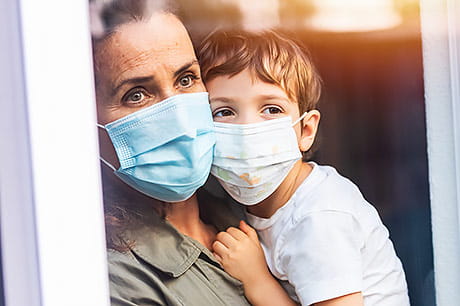Experiencing some stress and anxiety is a normal part of growing up, but sometimes it can be a bigger concern. Here’s how to spot the signs and how you can help your child.
From having first-day-of-school nerves and keeping up with schoolwork to meeting new people or trying something new — some stress and anxiety is completely normal, and many children will experience it.
And, most often, the stress and anxiety will pass once they finish that essay, get used to that new experience or get some reassurance from you, their parent or guardian.
But, as a parent, how do you know if what your child is experiencing is normal or if they’re dealing with an anxiety disorder that requires help from a pediatrician or mental health professional? Rachel Lilly, PhD, pediatric psychologist at Geisinger Lewistown, helps us break it down.
What are anxiety disorders?
Anxiety disorders are common mental health conditions that generally cause feelings of fear, worry or distress in certain situations. They can affect the body, too — causing changes in behavior, sleep habits and eating.
“If left undiagnosed and untreated, an anxiety disorder can worsen over time, causing significant disruptions in a child’s life,” Dr. Lilly says.
Some anxiety disorders that commonly affect children are:
- Generalized anxiety disorder (GAD)
- Obsessive-compulsive disorder (OCD)
- Panic disorder
- Phobias
- Selective mutism (SM)
- Separation anxiety disorder
- Social anxiety disorder (SAD)
As with adults, anxiety disorders affect girls more often than boys, and each child may respond a little differently depending on their age, maturity level or coping skills.
“Children don’t often understand their anxiety or what’s causing it,” Dr. Lilly notes. “Because of this, they can display a variety of behavioral or physical symptoms that can be hard for parents to pinpoint.”
Signs and symptoms of anxiety in children
Symptoms of anxiety in children (and adults) are a result of the “fight or flight” response, which is the body’s normal response to danger. This response releases chemicals in the body that affect heart rate, breathing, muscles and digestion. “With anxiety disorders, the ‘fight or flight’ response takes place even when there’s no danger,” Dr. Lilly says.
Though not a complete list, the following symptoms are often seen in children with anxiety disorders:
- Bedwetting
- Behavioral changes, such as moodiness, aggression, temper tantrums, clinginess or frequent crying spells
- Complaints of stomachaches or headaches
- Constantly worrying or having negative thoughts
- Decreased or increased appetite
- Difficulty concentrating
- Fears, like a fear of the dark, being away from home or interacting with peers
- Hoarding items of seeming insignificance
- Sleep problems, waking in the night or having nightmares
- Struggling with or refusing to go to school
- Withdrawing from family or friends
To help differentiate between an anxiety disorder and a medical concern, you may want to take note of when your child displays certain behaviors or complains of physical symptoms. Is it before or after a certain event? For example, does your child cry or complain of a stomachache before going to school? Anxiety may be the cause.
When to call your pediatrician
Because symptoms can vary, anxiety in children isn’t always easy to spot. It’s also possible for a child to be struggling with an anxiety disorder and not show the symptoms listed above.
“In general, if your child is displaying any odd behaviors or physical complaints, it’s a good idea to talk with their pediatrician,” Dr. Lilly says. “They can help diagnose an anxiety disorder and get your child the help he or she needs to manage it.”
Commonly treated by a mental health professional through cognitive behavioral therapy (CBT), or a form of talk therapy, you and your child can learn ways to better manage their fear and anxiety. And without fear and worry impacting their life so much, your child can get back to doing what they do best — being a kid.
Next steps:
Learn more about Rachel Lilly, PhD
Back to school 2020: Tips for keeping your child healthy all year
Can’t keep your kids off the web? Learn how to keep them safe


